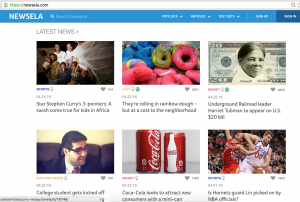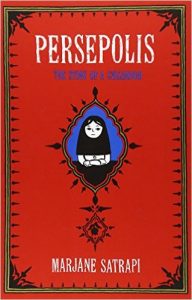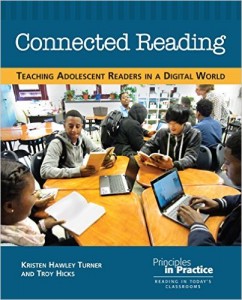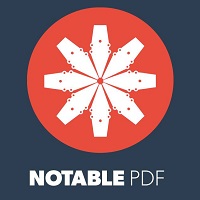 In May, as the school year was winding down, I was met with an all-too-common challenge: running out of time. There were about four weeks left, and the calendar was quickly filling with standardized tests, field trips, and sports competitions. I needed two solid weeks of writing workshops with my tenth graders to complete their final writing piece–an op-ed–but it looked like ten kids would be gone each day for the next four weeks.
In May, as the school year was winding down, I was met with an all-too-common challenge: running out of time. There were about four weeks left, and the calendar was quickly filling with standardized tests, field trips, and sports competitions. I needed two solid weeks of writing workshops with my tenth graders to complete their final writing piece–an op-ed–but it looked like ten kids would be gone each day for the next four weeks.
I addressed my problem by adding some flipped mini lessons to my writing workshop. Instead of starting class every day with a mini lesson in class, I did a screencast of the same lesson and assigned it for homework. One night the students watched a ten-minute video about improving their diction in their op-eds. Their assignment was to show me where they’d made an intentional choice with their diction. In class, I could quickly check in with each writer, give some feedback about their diction, and assess their understanding of the skill. And my absent students didn’t miss any key instruction!
I was really happy with how the unit worked out for two main reasons. First, I felt like I was stealing back time for writing workshops to do the thing that is key to improving student writing: face-to-face conferences. Second, I was assigning purposeful homework that was giving my students a chance to practice, without their being overwhelmed or confused.
That’s how I ended the year. As I get ready for this new year, I’m wondering how I can expand on this success from the spring. Most kids will tell you that one-on-one time with a teacher has the most impact on their learning. Most teachers will tell you that one-on-one time with their students is the most effective way to move the needle with their learning. So this fall I’m committing to stealing as much of that time back as I can, in the following ways.
Day One Overview
Course procedures and the course overview are brutal. On one hand, you want to go over some key information with the kids. On the other hand, it’s the first day!
I want to start building my classroom community. I want them writing. This year, I’m going to steal time by flipping my procedures and course overview. The students’ first night homework will be to log into our Google Classroom page, watch a (short!) screencast of the course overview, and answer a question or two in a Google Form for me.
I’ll be able to gather some information about the students, and ensure that they all know how to log into Classroom. And I’ll free up a whole class period for some opening writing, reading, and community building.
Differentiated Reading Instruction
Last year I flipped my writing workshop mini lessons, but why not use technology with reading instruction as well? My students are all at very different places with their ability to read and annotate complicated texts. Typically, we practice reading strategies as a whole class. We often need a whole class period to work through a text together. We will still do that sometimes, but what about assigning different texts (based on student ability and interest) and using different online tools to help students practice on their own?
Last year, Amy Gurney wrote about Newsela and its potential for differentiating reading instruction. That’s a great tool to add to my blended workshop toolbox. While students practice, I can do one-on-one reading conferences.
Examining Mentor Texts
At various points in reading and writing workshops, I like to examine mentor texts with the students. Sometimes we’ll look at a professional piece of writing to consider how the author develops an argument. Other times, we’ll look at a student essay and discuss what is going well and what the student may want to revise.
This is a great whole-class activity and a valuable use of time. But, sometimes that whole-class examination could be replaced with a video of my reading and annotating the text. Apps like ExplainEverything make it very easy for me to create a quick video. Students can see and hear my thinking as I read and process a text. The time saved could be used talking one on one about the students’ writing.
I am certainly not advocating that you replace your teaching with a series of online lessons. I will always believe that the best teaching occurs when you are working one on one with student writers and readers.
Still, the reality of modern schedules and schools means that we won’t always have as much time for the deep discussions that we need. Blending technology into my reading and writing workshops means taking various tools and using them to refine and enhance my teaching. As I start the 2016 school year, I want to be purposeful about how I use technology tools to free up time, in order to go back to the basics: face-to-face discussions between readers and writers.
 Hattie Maguire (@TeacherHattie) is an English teacher and Content Area Leader at Novi High School. She is spending her sixteenth year in the classroom teaching AP English Language and Composition, AP Seminar and doing Tier 2 writing intervention. She is a National Board Certified Teacher who earned her BS in English and MA in Curriculum and Teaching from Michigan State University.
Hattie Maguire (@TeacherHattie) is an English teacher and Content Area Leader at Novi High School. She is spending her sixteenth year in the classroom teaching AP English Language and Composition, AP Seminar and doing Tier 2 writing intervention. She is a National Board Certified Teacher who earned her BS in English and MA in Curriculum and Teaching from Michigan State University.


 This summer, my Theory of Knowledge students will read two independent books in preparation for the second semester of the course. Down the hall, my colleague Hattie (you know her from her
This summer, my Theory of Knowledge students will read two independent books in preparation for the second semester of the course. Down the hall, my colleague Hattie (you know her from her  The Comic Book Flood
The Comic Book Flood






